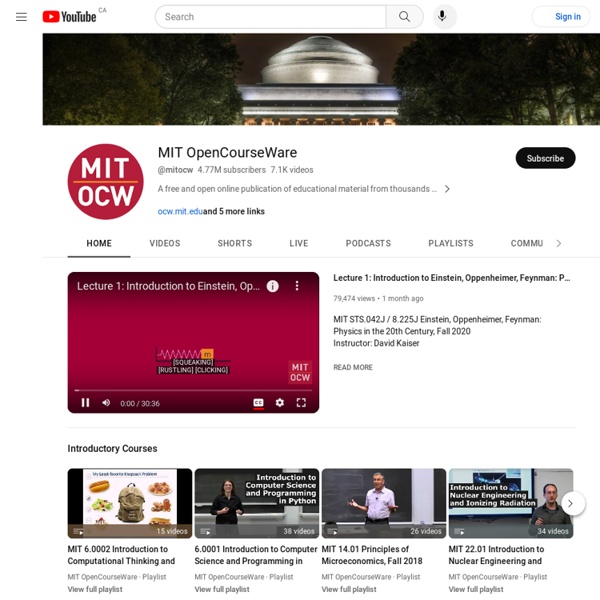



https://www.youtube.com/user/MIT
Related: EstadísticaMondrian - Interactive Statistical Graphics in JAVA This program is free software; you can redistribute it and/or modify it under the terms of the GNU General Public License as published by the Free Software Foundation; either version 3 of the License, or (at your option) any later version. This program is distributed in the hope that it will be useful, but WITHOUT ANY WARRANTY; without even the implied warranty of MERCHANTABILITY or FITNESS FOR A PARTICULAR PURPOSE. See the GNU General Public License for more details. You should have received a copy of the GNU General Public License along with this program; if not, see < Binaries for Windows, MacOSX and Linux: 1.2 as of 1/11/2011. Changes in Version 1.0 as of 12/18/2008. - Autostart of Rserve under Windows and Linux - Searchable variable list window - Missing value plot is compatible to color brushing now
Continuous Functions and Classifying Discontinuities Intuitive Notions and Terminology Thinking back to our intuitive notion of a limit, recall we said that barring any knowledge of what a function does at a particular x-value (as shown in the graph below when x=2), a limit can be thought of as an "expectation" for the height of the function at this x-value -- under an assumption that near this x-value, the graph of the function could be drawn with a single continuous stroke of a pen. As we saw, this expectation, even if it exists, need not agree with the actual behavior of the function at the x-value in question.
Learn and Teach Statistics and Operations Research Back in the mid1980s I was a trainee teacher at a high school in Rotorua. My associate teacher commented that she didn’t like to give homework much of the time as the students tended to practise things wrong, thus entrenching bad habits away from her watchful gaze. She had a very good point! Bad habits can easily be developed when practising solving equations, trigonometry, geometry. Recently the idea of the “flipped classroom” has gained traction, particularly enabled by near universal access to internet technology in some schools or neighbourhoods. When one “flips” the classroom, the students spend their homework time learning content – watching a video or reading notes. Jacob Fox Hello! I am an Assistant Professor in the MIT Department of Mathematics. I completed my Ph.D. in mathematics at Princeton University. My advisor was Benny Sudakov.
Classification of discontinuities in a removable discontinuity, the distance that the value of the function is off by is the oscillation;in a jump discontinuity, the size of the jump is the oscillation (assuming that the value at the point lies between these limits of the two sides);in an essential discontinuity, oscillation measures the failure of a limit to exist.limit is constant A special case is if the function diverges to infinity or minus infinity, in which case the oscillation is not defined (in the extended real numbers, this is a removable discontinuity). Classification[edit] For each of the following, consider a real valued function f of a real variable x, defined in a neighborhood of the point x0 at which f is discontinuous. Removable discontinuity[edit]
0xDE One of the new papers on arXiv this week looks to me like an example of exactly what theoretical algorithms research should aim for: simple algorithms with nontrivial analysis, providing new and practical solutions to an important problem in which previous solutions were unsatisfactory. Unfortunately, the previous solutions were only unsatisfactory in practice, while from the theoretical point of view they were optimal; when this happens, it tends to make papers like this quite difficult to publish in algorithms conferences. The paper: "The Power of Simple Tabulation Hashing", by Mihai Pătraşcu and Mikkel Thorup, arXiv:1011.5200. The problem: hashing algorithms are designed to work well with hash functions that are truly random (chosen uniformly from all possible functions that map the keys to be stored in the hash table into indices).
14.2: Limits and Continuity - Mathematics LibreTexts We have now examined functions of more than one variable and seen how to graph them. In this section, we see how to take the limit of a function of more than one variable, and what it means for a function of more than one variable to be continuous at a point in its domain. It turns out these concepts have aspects that just don’t occur with functions of one variable. Course Catalog "Web forums are excellent." S. Clark, GlaxoSmithKline "Our company is coming to the end of our first year working with statistics.com as its primary provider of statistical training and I wanted to thank you for the excellent classes and overall service that you have provided.
Continuous Functions Uniform continuity is a stronger notion of continuity. Note that in the definition for continuity on an interval I we say "f must be continuous for all x0∈I" which means for all x0∈I and for some given ε>0 we must be able to pick δ>0 such that ∣x−x0∣<δ implies ∣f(x)−f(x0)∣<ε. However note that for x1,x2∈I the δx1 we pick for x=x1 may be different from the δx2 we pick for x=x2.